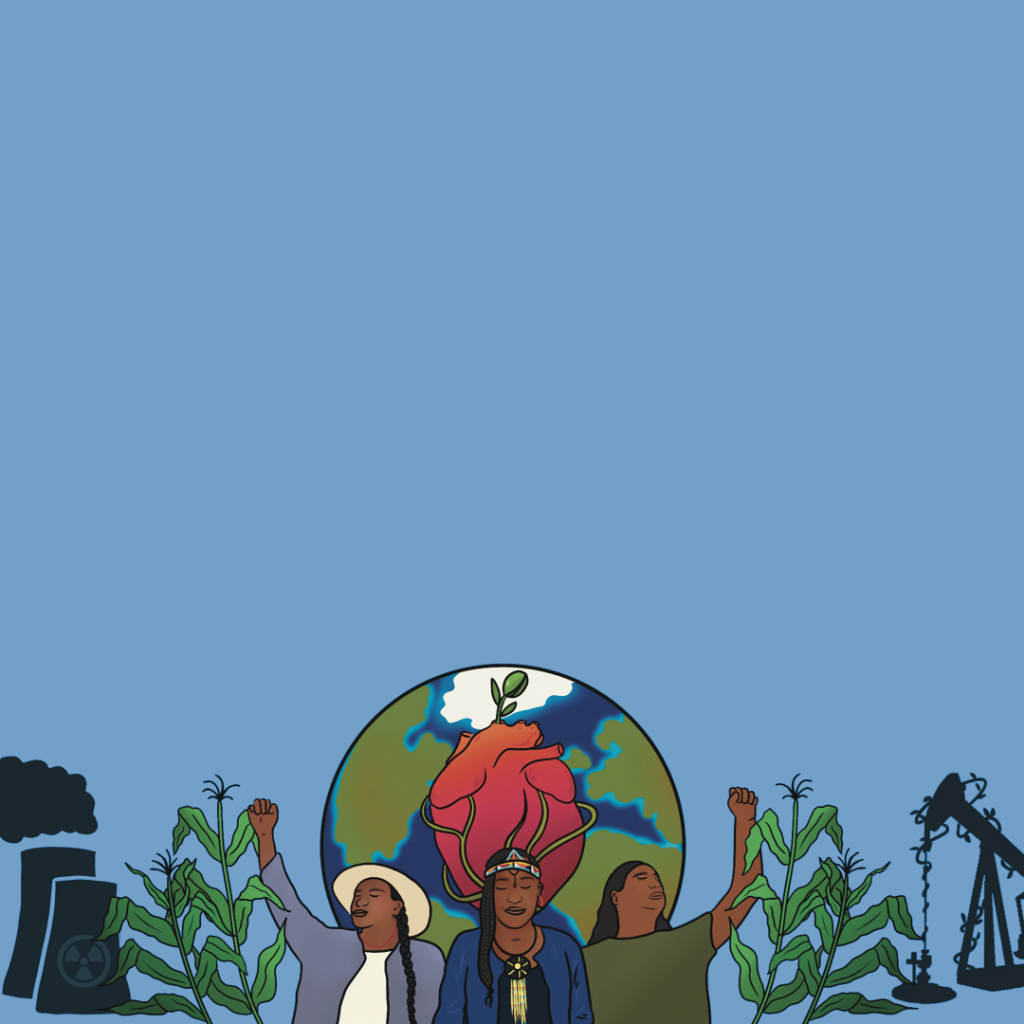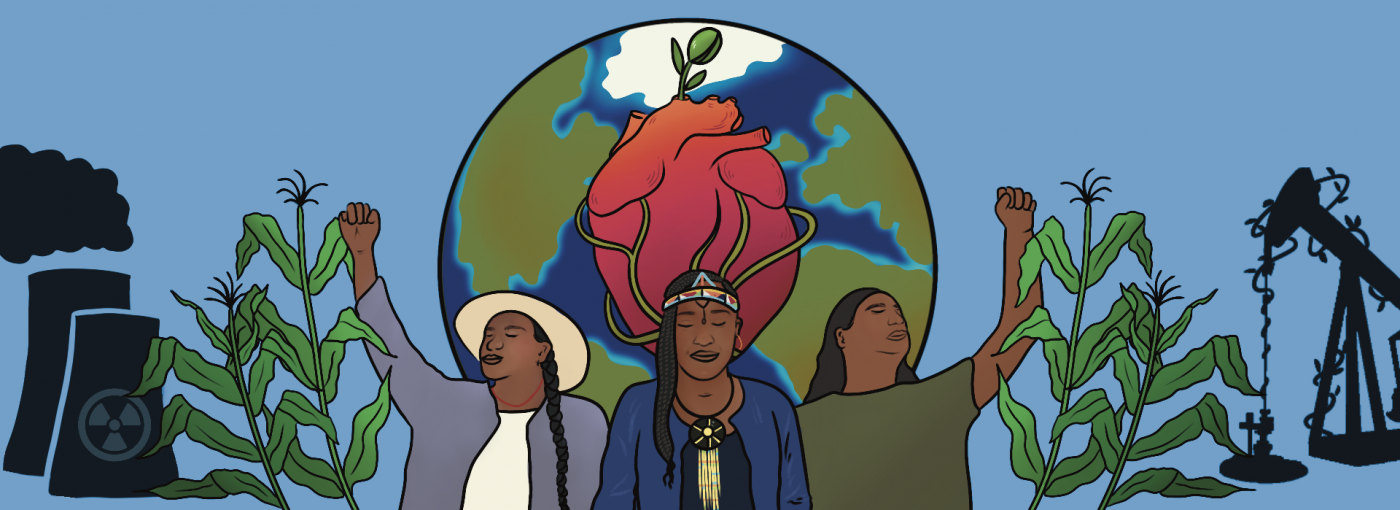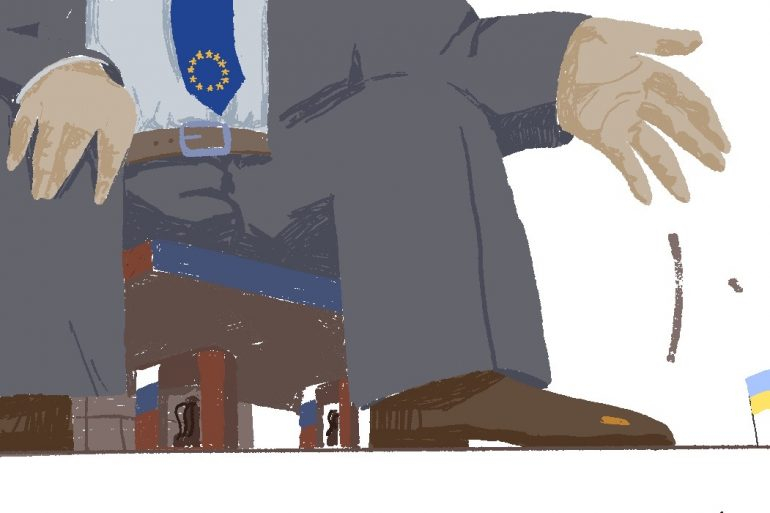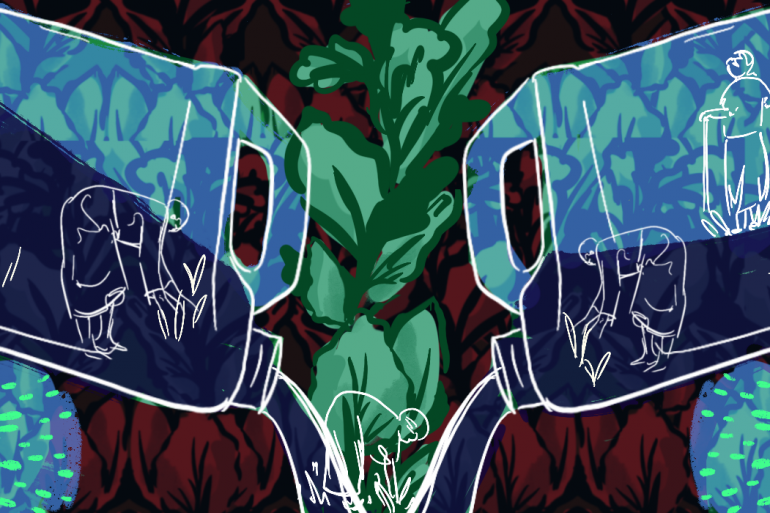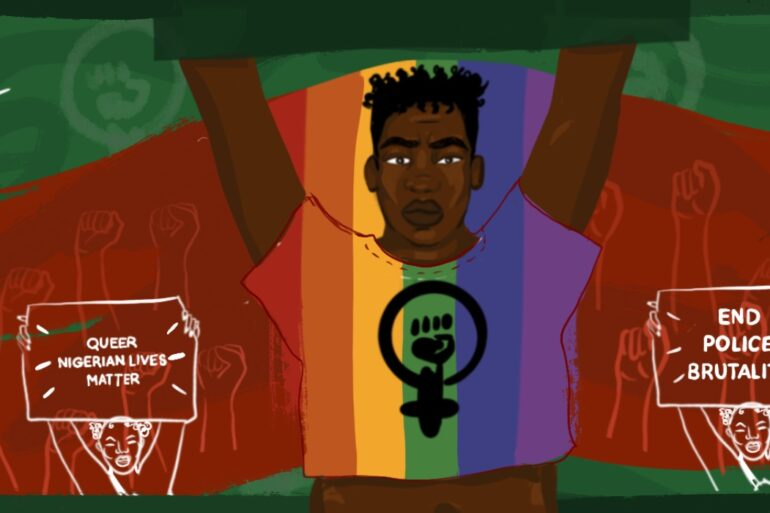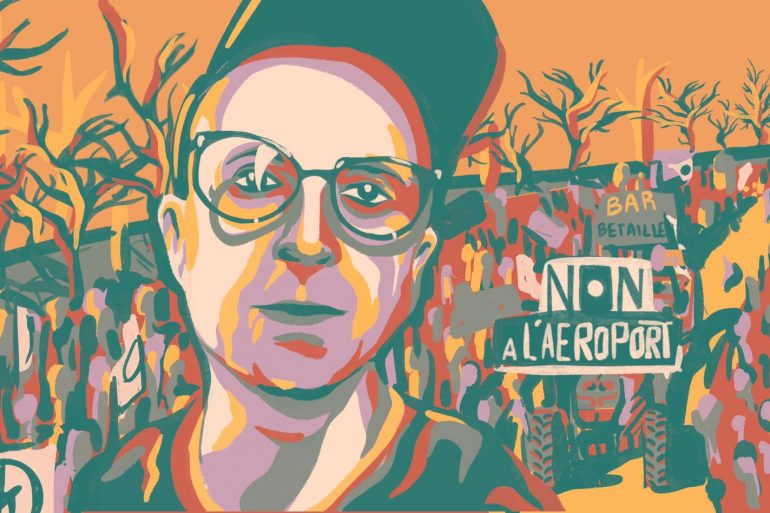This is what Elizabeth Wathuti, a Kenyan youth climate activist, urged the world’s decision-makers at COP26 last year, in what was one of the hardest-hitting speeches delivered at the UN climate change conference.
I remember her speech well. Last year was my first time attending a COP, and it shocked me how devoid of feeling the conference sometimes felt. The technocratic language had a way of sucking the life out of a room, but Elizabeth, or Liz, as she prefers to be called, breathed humanity back in.
Seven months later, I now see her in a very different context, but still with the same demand – and now her famous words are firmly planted on her t-shirt, too. She is sitting underneath the cool shade of a tree, taking a moment for herself having just spoken alongside climate activists Nina Gualinga and Adélaïde Charlier to a tented audience at Roskilde festival, one of the largest music festivals in Europe.
Coming from Kenya, Ecuador, and Belgium respectively, all three women emotively shared their personal experiences, weaving words designed to stir the crowd of festival-goers into action. As they expertly spoke on civil society’s power to beat the fossil fuel corporations, to rise up against government policies currently hurtling us towards a 2.4 degree future, the noises of Dua Lipa’s soundcheck were abuzz behind us – not your standard setting for a climate talk.
Passion is key
“I believe it’s really important to bring frontline stories to diverse platforms,” she tells me. “It doesn’t happen in cultural spaces enough and I think it’s something that could really help. I’m a strong lover of music, I know how much music can inspire you. Your whole inner self gets carried away by the music – and for me, it’s the same way I feel about the planet.”
At that moment, the jubilant, rhythmic beats from the Beninese all-girl crew, Star Feminine, performing nearby, rise up and blend into her words. We acknowledge the moment’s symmetry and laugh.
For Liz, solving the climate crisis isn’t about “the big terms we use in science” – it’s about emotion. It’s about sparking people’s humanity and asking them to love people and the planet equally, the same way you might love music.
“Anyone who has been passionate about something can be passionate about loving the planet and our people,” she tells me. But passion in the climate movement can sometimes hold heavy responsibilities.
Movements, by nature, cannot solely be carried by individuals platformed by the media and large social media followings. But all too often, we see how the world has asked for too much from climate influencers, greedily extracting from the passion instead of nurturing it and causing many to suffer from burnout.
Roskilde is just one of many destination points on Elizabeth’s climate-speaking tour around Europe. Jumping from conference to conference, she has been asking, once again, for the world to “open (their) hearts” so that the urgent action required to safeguard the lives and livelihoods of communities in Sub-Saharan Africa – a population which has contributed just half a percent of the world’s total carbon emissions – is taken.
“It’s draining – emotionally and physically – to carry all these messages with you. Especially when it takes you away from home for such long periods of time,” Elizabeth says. “I recently got to that point where I just needed to recharge.”
“Nature helps me,” she continues. “Having that connection to nature is important to counter depressing spaces like the World Economic Forum or COPs, which are filled with so many frustrations about the negotiations.”
Liz excitedly tells me how she recently visited Richmond’s Park ‘Fallen Tree’ in London, also known as the “phoenix tree” according to the UK’s tree of the year competition. The tree earned its accolade for its sheer tenacity to rise again after brutal high-winds blew it over into a horizontal position. Its branches now grow all from the upward side of its trunk, each one reaching to the sky like a small tree in itself.
Its story illustrates nature’s stunning adaptive qualities, but also shows how damage inflicted by extreme weather events can be repaired with the right resources. For the phoenix tree, the soil and the conditions after the event were enough for a chance to start again.
On the frontline
The reality for many communities living in climate vulnerable countries is much starker. With no financial resources to help them recover from climate-related loss and damage, the prospect of rising again is, in some cases, impossible.
The term ‘loss and damage’ is used in the UN climate negotiations to describe the negative impacts caused from the adverse impacts from climate change. Loss refers to the irreversible, damage to the repairable.
“In May, I visited a community in Wajir County to listen to their stories and to see how the drought is impacting them. It was really…” Liz pauses, hesitantly choosing her next words: “so much.”
She continues to paint a harrowing image of drought-induced desolation: dead goats and cows sprawled across fields, some fresh carcasses, others left to rot in the baking sun for weeks.
Livestock production accounts for 80% of the Wajir community’s livelihoods. Without rain, there is no farming, nowhere to get food, no money – “there is literally nothing for people to do other than to wait and hope,” says Liz. Many of those dependent on their livestock for income have been forced to pull their children out of school.
Subscribe to shado's weekly newsletter
Exclusive event news, job and creative opportunities, first access to tickets and – just in case you missed them – our picks of the week, from inside shado and out.

“Most of them are not even aware that they are suffering from climate impacts they are not responsible for,” Liz explains.
The other side of the coin
This experience is what compelled Liz to write a letter to the COP26 and COP27 presidencies (the UK and Egyptian governments) at the SB 56 (the first UN climate meeting since COP26 in Glasgow) urging the negotiations to agree on providing finance for loss and damage.
Strategically, the conference gave Liz an opportunity to listen to the arguments of those who have been blocking progress on the issue, historically being the US, UK, and EU negotiators.
“One of their reasons made me really sad,” she tells me. “They said that frontline communities are not ‘here’ – that it’s not ‘them’ asking for loss and damage finance.”
As Liz is unable to disclose to me which negotiator said this, I can only assume “here ” refers to one of the blockers, perhaps a country in Europe. But the claim that frontline communities are not in, what I assume is a northern country, is a fallacy. We need only to look at the deadly floods in Germany last year, or the ravaging wildfires here in London to see communities devastated by climate impacts. But northern economies have the financial resources to address loss and damage, for example, the German government created a $35 billion recovery fund after the floods, which is why communities are not (at least for now) calling for loss and damage finance. The negotiator’s words show their care for communities impacted by the climate crisis is bound by borders – an “us” vs “them” mentality, so to speak.
Liz then begins to speak to me as though I am the negotiator:
“I’m right here telling you – what do you mean frontline communities are not here?” Her frustration is clear. “We are literally telling you stories of what we are seeing at home. Lives and livelihoods are being lost. That’s what is at stake.”
She goes on to explain another negotiator’s feeble argument: that they just “don’t see the need” for it and they “don’t want to be held accountable.”
But who should pay?
Accountability and who should pay for loss and damage has long been a sticking point in the negotiations. In 2015, rich countries ensured there was a clause in the Paris Agreement outlining that loss and damage did not include or provide the basis for liability and compensation.
At last year’s COP, it was, of course, the biggest polluting and wealthiest economies who blocked the climate-vulnerable countries’ demands for a loss and damage fund. Progress was made, but only on the outside of the UNFCC process, as Scotland’s First Minister, Nicola Sturgeon, pledged $2 million to addressing loss and damage – the first dedicated fund of its kind.
But $2 million is just a drop in the ocean.
By 2030, loss and damage is estimated to cost between $290-580 billion in so-called ‘developing’ countries alone, and that’s only considering the things we can measure.
But life’s treasures, the things we truly hold most dear, transcend monetary value. We cannot put a price on the loss of loved ones, homes, biodiversity, community, languages, cultural heritage and much more. This is the heartbreak of non-economic loss, and how international policy will address it is another pressing question.
“We are calling for international solidarity and cooperation because loss and damage cannot be solved by one country alone,” Liz says. And nor should it be, especially when we consider the debt rich countries owe.
“Countries facing the devastating impacts from climate change caused by richer countries’ historical emissions are also those who have the least capacity to adapt and deal with the impacts due to limited financial resources,” she explains.
For Liz, loss and damage finance is therefore about collective action that seeks to rebalance the debt born from rich countries and fossil fuel corporations uninhibited pollution, and for countries to say: “yes, we’ve made mistakes in the past, but we still can fix this by working together – without division and without self-interest.”
But even once a loss and damage fund is agreed (once and not when), pledges made in the UN climate negotiations often make good-looking headlines in the moment, but lead to further frustration down the line.
Trust is eroding
Just this month, an OECD report showed that rich countries have fallen nearly $17 billion short on a climate finance pledge. The deadline for this sum was 2020 and research suggests that the US is mostly responsible. What’s more, the original target expected rich countries to deliver $100 billion towards mitigation and adaptation measures every year between the years 2020 and 2025. Whilst 2023 edges closer, rich countries have failed to materialise the $100 billion sum even once.
“The only way to rebuild trust between richer and poorer countries is to pay up for loss and damage and to pay up for all the commitments that have not been made,” Liz says. “But all the money in the world won’t resolve loss and damage, unless we take action to cut emissions too.”
Looking toward COP27
Much is riding on the next COP, which is to be held in Sharm El Sheik later this year, given the escalating climate impacts which have been so visible since Glasgow. From the record shattering heatwaves that gripped India and Pakistan, to the catastrophic floods, the worst seen in living memory, which hit Bangladesh; from the repeated storms which battered South Africa, and the wildfires that ravaged Europe and the UK, and the worst drought in 40 years taking hold of countries in the Horn of Africa – the need for a loss and damage fund has never been so abundantly clear.
Many have started to call the next UN conference the “African COP.” I see a flinching grimace appear on Liz’s face at my use of the phrase.
“We cannot call it an African COP just because it is happening on African soil. That is not enough. It has to be inclusive for African people and the outcomes negotiated must reflect the present needs of the African continent, and those needs are not anywhere close to being fulfilled.” Accommodation prices in the affluent tourist destinations have unsurprisingly skyrocketed, making it already inaccessible to frontline communities unable to afford such hefty bills.
“Voices from the African continent cannot just be on the sidelines, but in the negotiating rooms. That is how the outcome will reflect our needs,” Liz urges.
One thing’s for sure: Liz is far from the sidelines. She is an inspiration and a change-maker through and through. Public speaker, activist, and founder of the Green Generation Initiative (a youth-led initiative tackling environmental issues by empowering communities to act through education, tree growing, and activism) she is making waves wherever she goes. And with her emotional appeal to the world, she reminds us that we need only to look in ourselves to find the compassion that powers enduring climate action.
What can you do?
- Sign Elizabeth’s online petition calling world leaders to deliver loss and damage finance
- If you are under the age of 35 you can join the loss and damage youth coalition
- Get involved with Loss and Damage Action Day this September 22nd
- Roskilde Festival 2023 will take place from Saturday 24 June to Saturday 1 July. Find out more at roskilde-festival.dk and follow the official 2023 event on Facebook.
